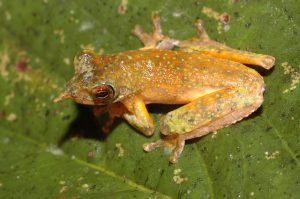Courtesy of Queensland Museum
What do pinocchio, a cheeky monkey and a parachute have in common? They are three new species of frogs recently described by a Griffith University and Queensland Museum scientist and his colleagues.
The trio of frogs were discovered in New Guinea’s rugged forest covered mountains and are incredibly rare, with scientists having only seen each of these species just once.

Litoria visissimia. Credit: Stephen Richards
Queensland Museum senior curator Dr Paul Oliver said all three frogs were unique and remarkable.
At first glanceLitoria pinocchioandLitoria vivissimialook like typical small tree frogs, but on closer inspection a small spike like a short nail can be seen protruding from the tips of their snouts.
The third species,Litoria pterodactyla, is a parachuting frog, with extensive webbing on its fingers that is used for gliding out of its treetop home.
“It’s pretty obvious how we came up with the nameLitoria pinocchio— it refers to the distinctive spike between the frog’s nostrils,” Dr Oliver said.
“AndLitoria vivissimiatranslates to ‘cheeky monkey’ – we have probably walked past dozens of them but have only ever seen one. We think they are probably up there in treetops laughing at us.”

Litoria pterodactyla. Credit: Stephen Richards
Dr Oliver said the third species, the parachuting frog, is a large green frog with violet thighs.
“Its name translates to ‘winged fingers’, referring to its extensive violet finger webbing that it uses to parachute out of trees,” Dr Oliver said.
Dr Oliver said these elusive frogs were some of the most remarkable species described from New Guinea over the last decade, and their discovery is yet more evidence that this wet mountainous island is a global hotspot of frog diversity.
Queensland Museum CEO Dr Jim Thompson said the work of Queensland Museum scientists stretches beyond the state.
“Queensland Museum has a team of world-class scientists whose work contributes to the overall knowledge of biodiversity around the globe and discoveries such as this are just a small aspect of the work our scientists and curators perform daily,” Dr Thompson said.
The papers featuring the three new species were recently published in Zootaxa.
